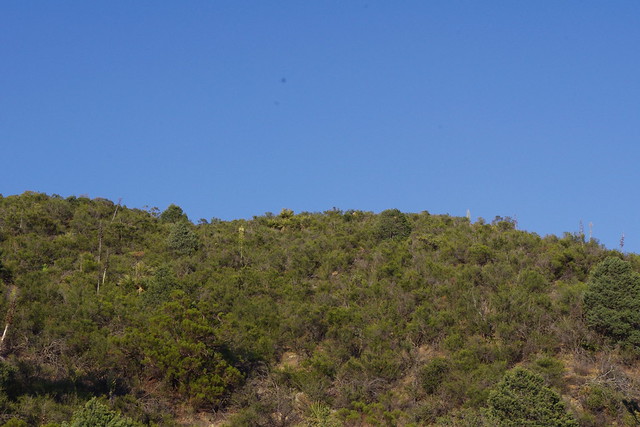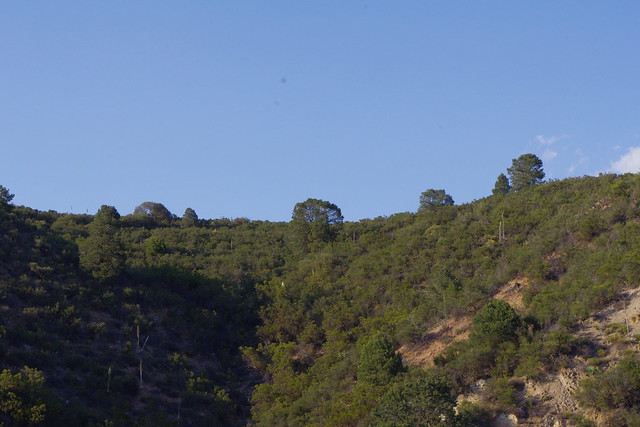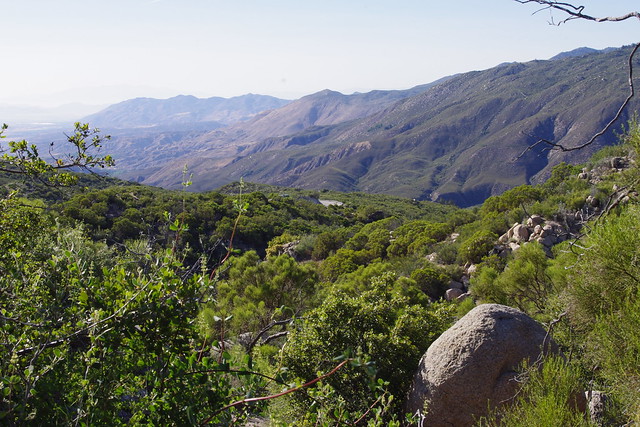Chamise (Greasewood) Adenostoma fasciculatum a Major Forest Plant Facilitator
 |
| Image - Josh Williams |
Contrary to the Chamise (Adenostoma fasciculatum) chaparral plant's derogatory other name as "Greasewood" which attempts to exaggerate it's Biogenic Volatile Organic Compounds (BVOC) Sap content which will readily burn like any other plant, the plant gives more life than it supposedly takes. Yes it contains oils that will burn, but so do other plants. Even Tropical Rainforests can and do in our modern world burn with a voracity, but usually only as a result of human intervention. Yes it is most notable in Brushfire events, but only because it usually is the most abundant interior region plant for which human developments themselves invade it's habitat for housing projects. Recent findings however are proving just how valuable this chaparral shrub and possibly it's cousin Redshank or Ribbonwood really are in forest re-establishment. Not only for it's incredible ability at Hydraulic redistribution, but also the fact that during wetter years, both of these chaparral species can be colonized by an ectomycorrhizae called Pisolithus tinctorius which under the conventional belief, was never supposed to happen. They have always been listed strictly under endomycorrhizal hosting. I'll have to write about this in a future post. But it clearly does illustrate why during these wetter rainfall events such as "El Nino", that the spread of woodlands is much greater within the chaparral plant community. A plant community often demonized by those charge with it's management and trust as to custodianship like US Forestry.
 |
| Image - Mine |
This young Coulter Pine is wedged in between two Chamise chaparral plants near Ranchita California. These chaparral plants have extremely deep soil holding roots and can extract water from deeper soil layers and redistribute the moisture through the fungal grid network underground to sustain the young trees until they can manage on their own. In time the Chamise itself will yield to the woodland as opposed to the unfair reputation of chocking tree planting programs for which they are mechanically and chemically eradicated before a restoration project proceeds.
These next photos are a gallery of examples taken from the Burnt Valley Rd area of Anza CA and Hwy 371 traveling north from the eastern Burnt Valley Rd Jct and heading northeastwards towards Paradise Corners near Garner Valley. My main reason for taking these shots if you examine them carefully is that these slopes are all South and West facing and temps in summer here are extreme with drying winds. However, amazingly over the years, these particular Chamise (Greasewood) Adenostoma fasciculatum have acted as Nurse Plants to countless Parry Pinyon (Pinus quadrafolia). These Pinyons would not have made the transition from pinyon nut germination to young decade old sapling had it not been for Greasewood.
 |
| Photo Mine |
Steep Southern facing slope off Hwy 371 from Burnt Valley Rd Jct to Paradise Corners to the north. These are extreme hot dry locations where no self respecting tree would dare attempt to germinate and survive on it's own without the help of a nurse plant. In this case, Greasewood, with some stunted Redshank or Ribbonwood present. The soils here have very little organic matter on the surface, are known for continual dry (hot or cold) windy conditions along with shallow top soils and loads of fractured rock. As long as mycorrhizae is present, no problem. In this case, the area is extremely rich in Pisolithus tinctorius which is abundant everywhere and one of my most favourite personal major truffle or puffball collection areas. Most of my collecting has been around the old Dunn Ranch now owned by Agri-Empire.
 |
| Photo Mine |
Another scene from the highway 371 showing mature trees and numerous younger ones if you can pick them out in the photo. I wish I could have hiked over there and got some close ups, but time & money has not been friendly to me here. Fortunately I have not needed to start from scratch and explore for the first time. Bert Wilson of Las Pilitas Nursery asked me where I found the time to document this stuff. The reality is I've had 20+ years to explore this region and I have known exactly where to go and located what I truly discovered decades earlier to be prime examples of where Chmise or Greasewood is a valuable asset for the advancement and spread of forest and other woodland trees, something NEVER spoken about in most of the literature, with the exception of a couple examples.
 |
| Photo Credit: Mine |
This is another close up of the steep southern face of the hills in late afternoon. Had this been the right time of year and during a wetter rainy season, the contrasting background creamy white blooms of the Chamise would have allowed the bluegreen colour of the Parry Pinyon to stand out. Younger smaller trees would have been more identifiable. The planter of the Pinyon nuts of course is the Scrub Jay. The large nut itself is incapable of finding a spot and burying itself a couple inches under the dander of any Nurse plant.
 |
| Photo Credit Mine |
This is another close up of bigger trees and smaller ones in between. The location is steep south facing slope taken in late afternoon with Sun to the left of the photo. Unfortunately this was taken at the wrong time of the year. Had this been a very wet season, the bluegreen of the Parry Pinyon (Pinus quadrafolia) would have contrasted nicely with the creamy white blooms of the Chamise and then every tree (including and especially the smaller ones) would have stood out.
 |
| Photo Credit: Mine |
This is the same scene of the Baldy Mountain stream drainage which no longer flows and in which I wrote a post of it's history a couple days ago here: Cal-Trans Diversion of Baldy Mountain Creek Shut Down One Ecosystem and Destroyed Another Notice the Chamise and the chaparral wild Honeysuckle for which that plant was as abundant as the Greasewood and was itself supported by the Greasewood as a lattice and no doubt hydration mechanism. Now look over across the Cold Water or Dry Creek Valley at the north side with it's steep south facing slopes. the predominant chaparral plant is the infamous Greasewood. This is the major foundation plant all around the foothills of the San Jacinto Mountains.
~~~~~~~~~~~~~~~~~~~~~~~~~~~~~~~~~~
Update June 8, 2014
Relationship found between Chamise (Adenostoma fasciculatum) & Pisolithus/Rhizopogon symbiotic relationship during periods of excessive rainfall years.
When Mycorrhizae debunks the Scientific Orthodoxy on what & who they'll colonize
The above reference has major implications of how Chamise can be utilized as an important tool for forest rebuilding as opposed to demonizing the chaparral plant and stripping it off the surface of the soil imagining it to be competitive and invasive within it's own natural range. The later is an absurd and completely asinine belief based on a flawed worldview of survival of the fittest. The reality is they both mutually cooperate for the survival of each other.







No comments:
Post a Comment
Thanks for visiting and stopping by with your comments!
I will try to respond to each comment within a few days, though sometimes I take longer if I'm too busy which appears to be increasing.